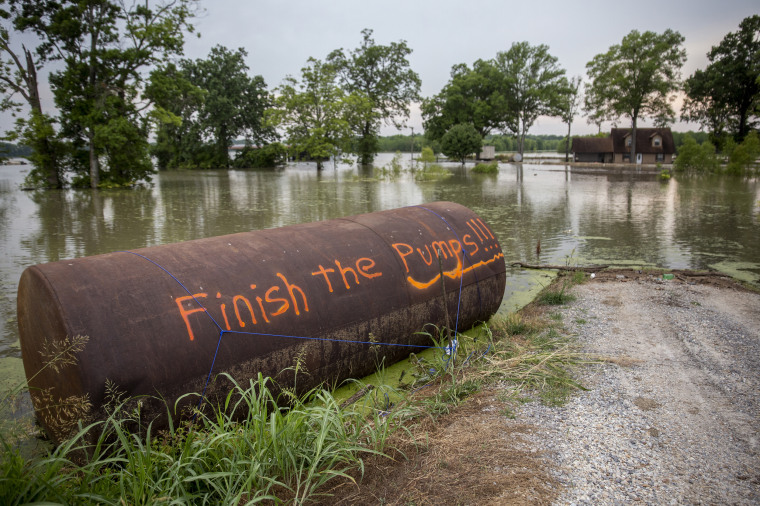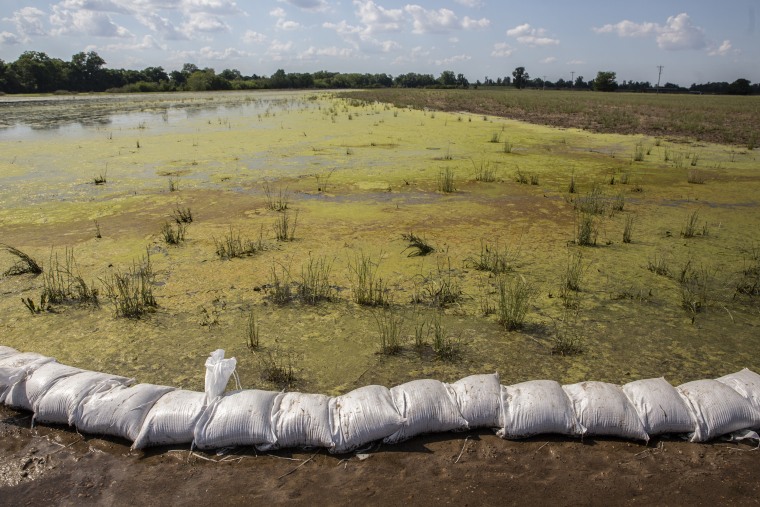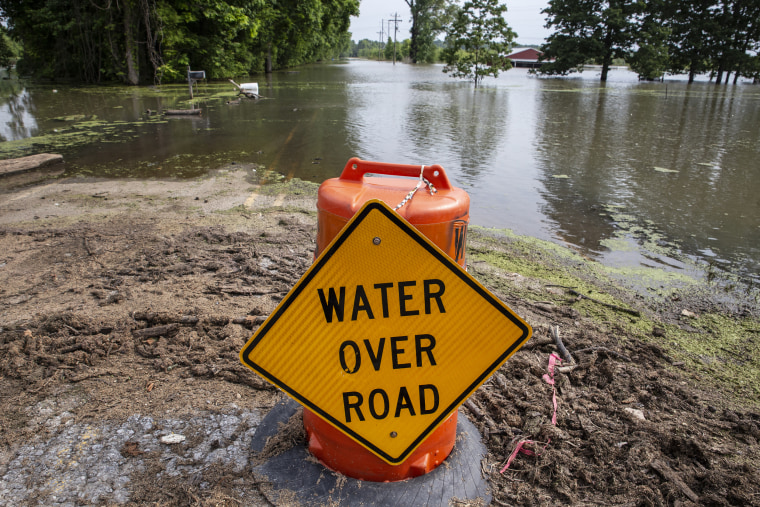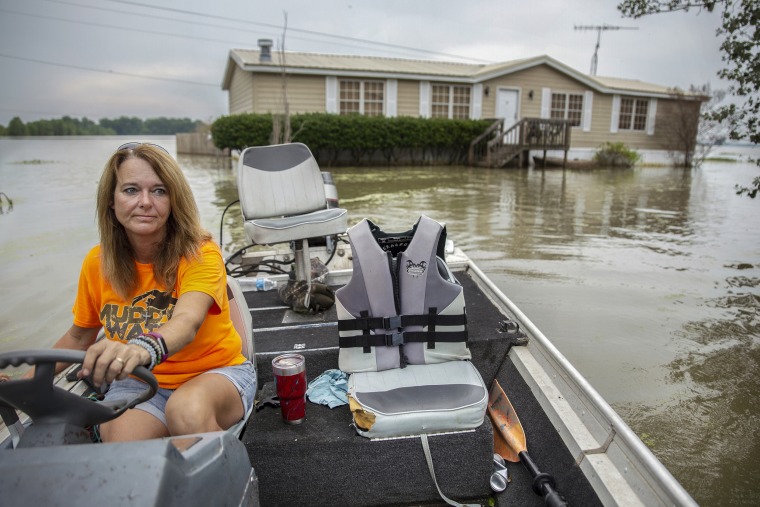This story was produced in partnership with Mississippi Today, a nonprofit news organization dedicated to civic engagement and public dialogue through service journalism.
REDWOOD, Miss. — The chest-deep water currently surrounding Stormy Deere's house is expected to remain there until at least July. The home she lives in with her husband is safely elevated on a mound of dirt and brick, but she has had to take a boat to reach it since early March.
Nothing has changed for months.
Deere, 44, loads her dogs on the boat twice a day when she must take them for walks, though she leaves the smallest one at home for fear of the alligators that live in these waters. This way of life, she said, is untenable.
“Emotionally, I have good days and I have bad days,” she said. “Some days I’m ready to go, some days I look outside and I want to despair. I want to just lie down and die. But that’s not an option.”
Record rainfall has led to the persistent flooding this year. That’s caused the Mississippi River at nearby Vicksburg to remain above flood stage, which is the water level that can cause massive flooding, for more than 114 consecutive days. That’s the longest span since 1927, according to the Mississippi River Levee Board. The water has also reached the highest level since 1973.
And while 2019 has been extreme, flooding in the Yazoo Backwater Area, as this part of the state is known, happens almost every single year. Since 2000, there have only been five years when it hasn’t flooded here.
Families that call this southern part of the Mississippi Delta home have put up with the standing water for months. They have attempted to draw attention to their plight via community meetings and social media — all to little avail.
The river has now laid waste to 550,000 acres of the Mississippi Delta, including 225,000 acres of farmland, and has affected more than 500 homes. But it is expected to rise again this week, entering a major flood stage, according to the National Weather Service, and those waters won’t recede until at least July.
“It is unbelievable just the vastness of this, and the hundreds of homes that are flooded, and the highways that are underwater, and the hundreds of thousands of acres of farmland that are underwater,” Peter Nimrod, chief engineer of the levee board, said.
Dubbed “the forgotten flood” by locals, it comes amid natural disasters that have caused billions of dollars of damage across the Midwest in the past several months and in turn claimed the national spotlight.
The difference is that in this part of the country, many residents believe there is a solution to their persistent, yearly flooding woes — if only the government would cut through the red tape to enact it. Locals like Deere believe that an unfinished Army Corps of Engineers project known as the Yazoo Pumps, a potential drain for the levee system that protects the Delta, would hold back the floodwaters that regularly threaten almost 20,000 people here.
Environmental advocates and longtime civil servants who have worked on the project, however, argue that the pumps come at a high cost, potentially draining tens of thousands of vital wetland acres that supports one of the most unique wildlife habitats in the country.

The project has been debated for almost 80 years, with frustration and anger building with the passing time.
Residents of the region, local farmers and Mississippi politicians are calling for the revival of the pumps — a project vetoed by then-President George W. Bush’s administration, called “one of the worst projects ever conceived by Congress” by the late Arizona Republican Sen. John McCain in 2004, and endlessly decried by environmental advocates.
Some believe the pump project could now find new life, despite unparalleled hurdles, thanks to renewed interest from the Trump administration. A few enterprising locals have even gone so far as to pitch in for two billboards that read: “President Trump, finish the pumps!”
As if in answer, the Trump administration announced that the Environmental Protection Agency would review the project after prodding from Mississippi’s congressional delegation.
Now Deere, like many here who have suffered from the widespread flooding, wants the government to act quickly and build the pumps, despite the fears of massive environmental degradation and the four years and hundreds of millions of dollars it would require.
“No one’s asking for the Delta to not flood. No one’s trying to drain wetlands. No one’s trying to kill the gnat or the pondberry bush. No one’s trying to take away the waterfowl hunting because we duck hunt, as well,” Deere said. “We just want what they promised.”
A silver bullet or a lie?
The pumps are a civil works project that have long loomed over this region since they were first proposed and authorized in 1941. Though they were never built, plans for the pumps were reviewed by the Corps in every ensuing decade except the 1970s — often at the direction of Mississippi politicians.
That still holds true.
Both Mississippi senators — Republicans Cindy Hyde-Smith and Roger Wicker — as well as Rep. Bennie Thompson, a Democrat who represents the Delta region, and Republican Gov. Phil Bryant have recently voiced their support for the pumps. It’s also a topic in a tight Mississippi governor’s race.
“It’s like the third rail of Mississippi politics: You have to be for the pumps."
“It’s like the third rail of Mississippi politics: You have to be for the pumps,” said Leonard Shabman, a water and environmental researcher who has worked with the Corps and the EPA on the pumps since the 1980s.
Now Mississippi politics has pushed the current administration to act, many noting that there are 22 federally funded pumps within 200 miles of the Yazoo Backwater Area. Every levee system in the lower Mississippi Valley has a pump plant except here.
The levees at these different sites create a bowl shape, and during high-flood events, those bowls begin to fill with water. A pump, the Mississippi Levee Board said, is the only effective way to help drain that water away and is necessary in this region.

An EPA spokeswoman said in an email that the agency has noted the “economic and disruptive impacts” of the Mississippi flooding and planned to find solutions.
“The Agency strongly supports the goals of improved flood protection and wetland protection for the residents of the Mississippi Delta,” she wrote. “EPA will work with the Corps and the local Levee Board to review updated data and other information as it relates to our regulatory programs and oversight.”
The discussion of pumps appears to arise whenever the area faces intense flooding, but environmental protection advocates and former civil servants who worked on the issue for decades didn’t think it would come up again after the EPA, under the Bush administration, vetoed the pumps in 2008.
It was only the 12th time in history that a project was vetoed under the Clean Water Act, and a federal court upheld the EPA’s right to veto the project when the Mississippi Levee Board sued in 2011.
When it came time for the veto, Ben Grumbles, the former assistant administrator for water at the EPA and Maryland’s current secretary of the environment, said he “proudly signed the decision.”
“It was a hard decision because EPA knew the area needed flood protection but our analysis of widespread environmental impacts, costs, and other complications fully justified the veto at the time,” he said in a statement to NBC News that emphasized that his views did not necessarily reflect those of Maryland Gov. Larry Hogan, a Republican.

Conservationists say the Delta’s bottomland hardwood wetlands create one of the most important ecosystems in the country. Twenty percent of the nation’s ducks, 450 different species, including 257 species of birds, rely on these wetlands’ natural resources.
They could be devastated by the pumps, according to the EPA’s veto, which said that 67,000 acres of wetlands could be drained if the pumps were installed. The agency also commissioned a report prepared by Shabman during his tenure at Virginia Tech that concluded that even if the pumps could guarantee that the area would never flood again, the amount of money saved is “far below what would be necessary to … justify such a project.”
Many who have long followed the case say the pumps are a pipe dream
Now, after the veto, it would likely take an act of Congress to authorize the pumps that are expected to cost north of $300 million. That or the unlikely prospect of overturning an EPA veto, something that has never been done before and would likely lead to a lengthy court battle with environmental advocates.
Considering those requirements, many who have long followed the case say the pumps are a pipe dream
“There are layers of reasons why this is a bad project,” said Melissa Samet, senior counsel at the National Wildlife Federation, who has followed the project for decades, ”but worst of all is it really gives a false promise of hope to people who are suffering from flooding.”
Unexplored alternatives
Jack Branning, 87, has owned his 2,500 acres of land next to the Delta National Forest since 1996. He said there’s 5 to 10 feet of water on parts of his property now, but flooding has been a persistent problem for him since he started farming in the area.
The floodwaters have gotten exceptionally high 10 of the last 11 years, he noted.
Because of those rising waters, Branning entered his property into the Wetlands Preserve Program in 1999, which provides him compensation for the land that he can’t farm if he allows it to be reforested.
“We did that because the program added value, in my opinion, to the land because the land had been cleared and being farmed unsuccessfully numerous years,” he said. “It may do okay for two years and then in two years the high water comes and it didn’t do very well. We farmed it for three years, I did, and it didn’t do very well.”
Branning said he’s happy that it’s helping the environment and noticed that some wildlife has returned, which is good for him as a hunter. Nevertheless, while Branning thinks he’s better off than his neighbors, he still supports the pumps.

“I try to see everybody’s point of view,” he said. “It all depends I guess on how you view the world. In the case of the backwater, I view the pumps as something that should have been done.”
Buyouts, wetland reforestation and raised homes and roadways are ideas proposed by Shabman in another report that he produced for the EPA about potential alternatives. Environmental advocates, however, claim local leaders were never curious to explore such ideas because they didn’t come with expensive construction contracts benefiting a small number of people in Mississippi.
Because of the environmental and financial costs, Grumbles said that the EPA moved forward with the veto in 2008 to clear the way for federal agencies to explore new solutions.
“Alternative, nonstructural flood control measures and measures that didn’t involve the large pumps (which would drain so many wetlands) never got much traction, so the only solution at the time was to use the veto pen and commit to work with the Corps, the levee board, and impacted communities in the future on a more acceptable project,” Grumbles said in his statement.
Still, nothing constructive happened in the decade that followed the veto. And because of the project’s expense, Shabman added, it is unlikely the pumps would ever have received funding anyway.
“The veto just made the thing end. No one picked up an alternative. No one said, ‘What else can we do?’” he said.
Shabman also thinks there’s little hope for the Trump administration to come up with an answer.

“If you look at what could be done between FEMA, EPA, USDA, the Corps and others, it’s possible you could do something that passes muster with the current authorization that would pass Congress and actually get funded,” he said. “But I’m not sure there’s that much creativity in this administration."
The debate matters little, however, to the people of the Mississippi Delta whose homes are now gone, damaged or under threat.
Mike Brown, a longtime resident who works as a trucker and farms corn and soybean on 700 acres near Redwood, said these alternatives ignore the simple fact that the place he calls home is now gone.
Four feet of water occupies Brown’s house right now, and he said he’s lost thousands of dollars renting a house south of Vicksburg for four months. In the meantime, he’s only received $500 from the Mississippi Emergency Management Agency since he had to flee his home and abandon part of his livelihood.
“We just need the government to finish what they started, finish the pumps,” said Brown, who recently found a casket floating in the floodwaters. “The flooding seems to get worse every year. It’s really damaging our livelihood, I’ve also got cattle, I do a little farming. It’s damaged everything that it can damage.”
Alex Rozier reported from Mississippi, and Phil McCausland reported from New York.



